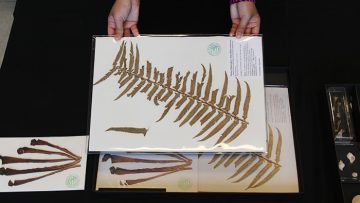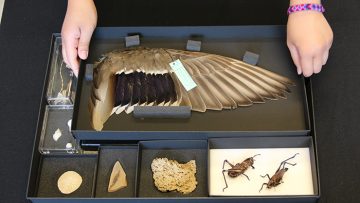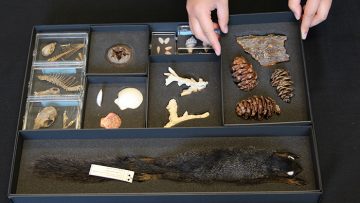Focusing on creating visual representations to record scientific observations, the Inquiry Beaty Box contains specimens, flashcards, and a suggested lesson plan so students can learn more about:
- The importance of sketching in the field of science
- The different types of techniques used when sketching natural history specimens
- Sketching as a way of identifying observable features of plants and animals
Request an Inquiry Box for your classroom here.
How to pack your Inquiry Beaty Box
Click here for a video on how to handle Beaty Box specimens.
Inquiry Box Dimensions:
- Length: 55.4 cm (21.8”)
- Width: 38.8 cm (15.3”)
- Height: 25.0 cm (9.8”)
- Weight: 5.94 kg (13.1 lbs.)

- Tray 1
- Tray 2
- Tray 2
- Tray 3
Sketching Lesson Plan
Learning Objectives: After this lesson, students should be able to:
- Identify the biodiversity of living things in the nature world
- Recognize the observable features of plants and animals
- Communicate observations and ideas by drawing and by using oral or written language
- Communicate through the arts using new artistic techniques and perspectives
Big Ideas & Concepts
- Arts Education
- K-1: Develop processes and technical skills in a variety of art forms to nurture motivation, development, and imagination
- Arts Education 2: Develop processes and technical skills in a variety of art forms to refine artistic abilities, reflect on creative processes and make connections to other experiences
- Arts Education 3-5: Connect knowledge and skills from other areas of learning in planning, creating, and interpreting works for art
- Arts Education 6-7: Demonstrate an understanding and appreciation of personal, social, cultural, historical, and environmental contexts in relation to the arts; interpret creative works using knowledge and skills from various areas of learning
- Arts Education 8-12: A variety of content links can be explored during this program.
- Science Education
- Kindergarten: Plants and animals have observable features; daily and seasonal changes affect all living things
- Science 1: Living things have features and behaviours that help them survive in their environment
- Science 2: All things have a life cycle
- Science 3: Living things are diverse, can be grouped, and interact in their ecosystems.
- Science 4: All living things and their environment are interdependent
- Science 5: Multicellular organisms have organ systems that enable them to survive and interact within their environment
- Science 6: Multicellular organisms rely on internal systems to survive, reproduce, and interact with their environment
- Science 7: The theory of evolution by natural selection provides an explanation for the diversity and survival of living things
- Science 10: Genes are the foundation for the diversity of living things
- Biology 11: All organisms have characteristics that define them as living and interdependent. Life can be organized in a functional and structural hierarchy ranging from cells to the biosphere; living things are interdependent; living things are diverse and evolve over time
- Biology 12: Cells are the basic unit of life
Educators Manual
- Each box comes with a comprehensive Educator Manual to provide you with all the information you need to confidently share and explore the Inquiry Beaty Box with your group.
- Manual includes:
- Beaty Box Basics
- Information on the specimens in the box - where they come from, how they are prepared, and information on how to handle them safely
- Information about the Beaty Biodiversity Museum
- Click here to download Beaty Box Basics
- Customized Lesson Plan and Specimen Information
- A lesson plan and list of relevant "Big Ideas" and "Core Concepts" outlined in the BC Curriculum
- Flashcards for each specimen with images and background information
- Suggestions and links to additional activities
- A USB key with a digital copy of the manual plus extra images and activities you can print off or download
- Click here to download the Inquiry Box Lesson Plan and Specimen Information
- Beaty Box Basics





